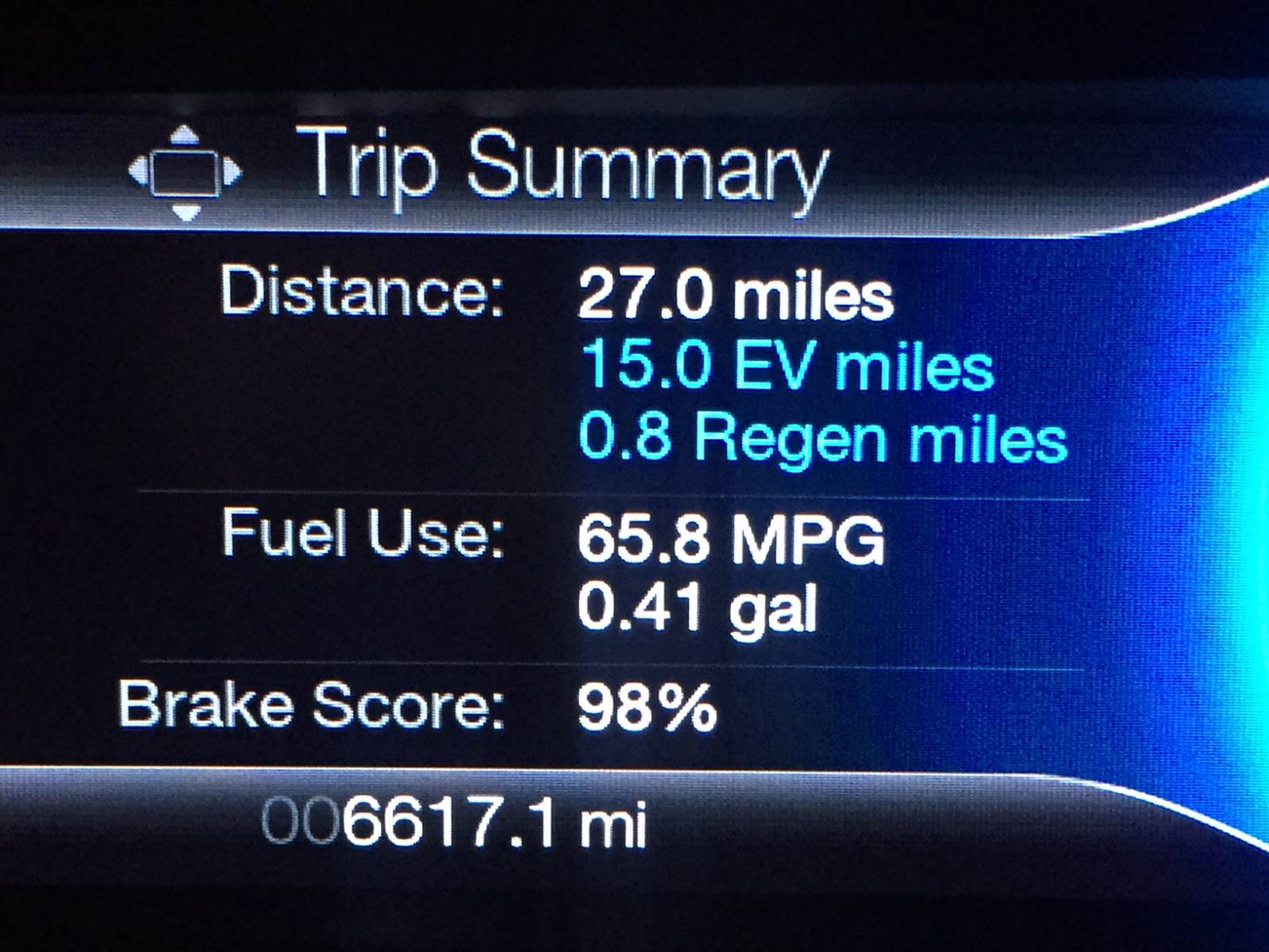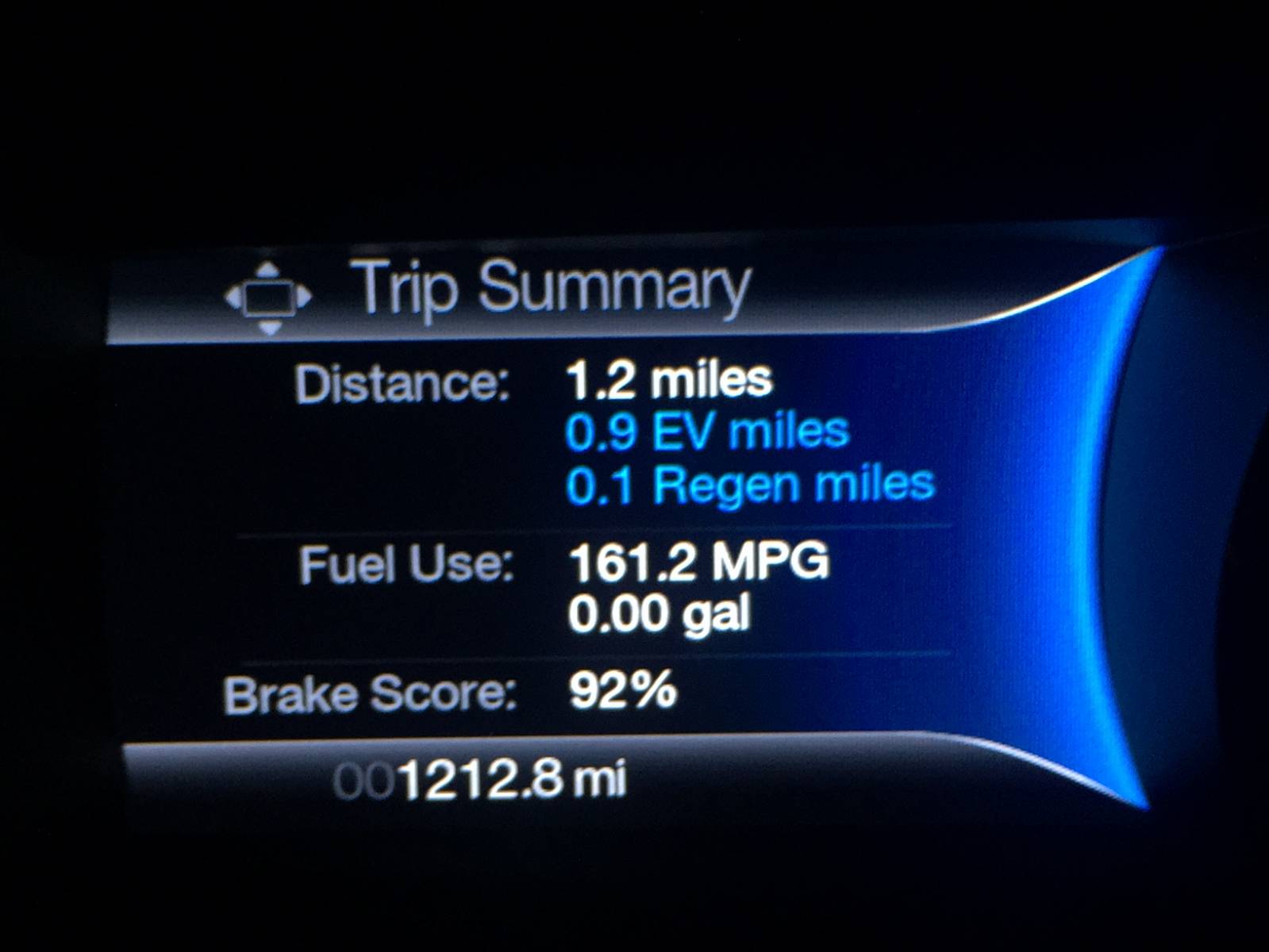Posts posted by wiscy67
-
-
Do we need a current subscription to Sirius XM to have the built in NAV recommend alternate routes due to heavy traffic? I'm beginning to wonder how useful NAV is without traffic analysis. My $60 Garmin has traffic analysis with no subscription needed.
-
I've seen at least a couple posts from others that support your hypothesis. Unfortunately they all seem to be from folks who are doing road trips. Therefore the same highway trips can't be repeated under the same/similar conditions but at different speeds to really test the hypothesis. It would be useful to design a test for a daily commute on the highway.
What I've seen in my highway travels (80% driving) still seems to indicate to me that for the same commute the greater the number of EV miles logged for that leg the higher the mileage I get. This is true for me when comparing the results for that same leg under similar conditions but with fewer EV miles logged for it. The way I vary the EV miles is by varying my speed. What I see is the faster I go the fewer the EV miles I log and the worse my mileage (when all other conditions are equal).
Hi everybody. I came to this topic after repeatedly encountering the same phenomenon as Aquineas. On road trips, I get better mileage when I travel at around 75 mph than when I travel around 65. The first few times I figured it was a fluke. But time and time again, I do better above 70 than below.
I have a theory. Most of my travels are in Pennsylvania, where it is usually hilly. When going slower, generally the ICE charges the battery uphill, and the car is in EV mode downhill. When going faster, the the battery assists the ICE uphill (hybrid drive), and the ICE is more likely to remain running while going downhill. It uses this time to charge the battery. Could it be that the latter combo of ICE/battery charging and assisting is more efficient than going into EV mode down every hill, draining the battery so it can't assist while going back up the hill?
-
System Restore (if it hasn't been disabled by the virus) is my preferred option for Windows PCs. Sometimes it needs to be run in Safe Mode with Command Prompt by entering rstrui.exe.
-
Yes, this is my experience as well. I usually have to hold the nozzle in place or it shuts off right away. However, during my last fill-up I happened to use the opposite-side pump at Costco and noticed that it stayed in (kind of sideways) by itself with no problem.
-
Texasota,
After logging 5 fill-ups since I turned on the Enhanced setting I'm seeing what you and others have experienced - fluctuations. I think 3 have been spot on including my last one where car reported 11.42 gal used and the actual was 11.36 gal. But 2 have been off including actually using 10% more than car displayed. Currently car lifetime shows 47.8 mpg and fuelly (actual) shows 46.6 mpg.
I occasionally get a result similar to yours (manually calculated and trip 1 agreeing reasonably close) and then on subsequent tanks the trip computer will be wildly inflated. A few recent examples from my spread sheet of this bizarre inflation are 5.09, 6.01 and 8.06. I love this car but I think he has bi-polar disorder.
It would be interesting to see your results over several tanks and see if it continues to be consistent for you.
-
Hybrider, Obviously pretty impressive. Can you remind us of your commute profile - I'm guessing by the high % of EV miles that it's not freeway? I drive about the same as your 25.7 mile trip but on the freeway at 65mph and have only been able to achieve about 14.5 EV miles at most.
I bet Elle would cringe if she saw it's been over a month and a half since anyone showed some love for her great topic. :) The temperatures should be warming up nicely by now for our Northern FFHers, at least I hope so.
So here's my last bit of Southern winter happiness before I spend the next few months with the A/C running everyday during my commute.
So it looks like 62 MPGs should be doable in an FFH for an extended amount of driving, at least under conditions close to perfect for FFHs.
And here's a shot of my new personal best MPGs for my commute, and which contributed to my best MPGs so far in the previous pic.I originally had thought that our FFHs were able to get better gas mileage with the coldest temperatures possible, at least those temps that didn't require us to run our heaters or defrosters, in which doing so noticeably impacts my MPGs.But now I know that my driving techniques were what was improving at the same time that the temperatures were going down at the beginning of this winter. And since recently the temperatures have been increasing here to the point of needing to run the A/C, my MPGs have been still going up. And I know my driving techniques haven't improved any during that period of increasing temperatures, so it has to be the temps going up that is causing the improvement in my MPGs recently.So now it seems to me that having the highest temperatures possible without having to run the A/C does allow the highest possible MPGs, at least in my FFH. I actually think my MPGs would probably continue to rise with the increasing temps here, as they are starting to climb above 90° now. But alas I probably will never truly find out if that is true since I can only handle using the slightly rolled-down windows for cooling up to about 85° or so before I start to break out in a sweat and give up and turn on the A/C.My FFH makes me feel like a scientist with all of the experiments and mental data collection it allows me to do in the name of getting that last bit of MPGs that I can.
-
-
I keep EV+ on but I still like to think I control the amount of SOC as I arrive at home. If I think it's getting to low at my destination or any time I can toggle out of EV with a quick tap of the gas pedal. As I leave my home the next day I keep it in EV mode while I drive the short distance to the main intersection. That way I'm in EV as I idle and wait for a clearing in traffic or light to turn green. Once I accelerate onto the parkway ICE activates and warm-up begins.
I also like to make sure that SOC isn't too high as I arrive at home. When that happens as I accelerate onto the parkway the next day my SOC can go even higher until completely full. Then when the battery indicator shows completely full I wonder if I'm no longer able to capture regenerative braking energy as I come to a stop or benefit from charging EV during extreme downhills.
-
-
Thanks for all the info. I now have something else to keep me obsessed (as my family calls it) and just as the novelty of having my first hybrid was starting to wear off. So far I haven't had any luck getting the car to stick in that particular ICE mode right before it switches to EV. As I tap the gas I'm either too late or too light and it switches to EV anyway. Or I press too hard and it stays all white briefly before returning to normal ICE.
Why can't there be a configurable setting for driver to elect to stay in "Optimized ICE" where possible instead of switching to EV?
hybridbear reacted to this -
Thanks for starting this thread. Since I do at least 80% highway driving in my '14 FFH any discussion around improving efficiency / mileage on the highway is interesting and useful for me.
So far with my experience driving on the highway I haven't found that I am able to increase mileage by reducing EV miles. Is there any way you can shed more light on your approach to:
"employ the strategy of forcing a near-full charge to the HVB and keeping the ICE running at maximum efficiency"
Perhaps I can try this on my daily route and report back how it affected the results? Are you saying you are able to prevent the car from switching to EV mode? If so, how? Also is there any way using the gauges on the car how I can measure if ICE is running at maximum efficiency?
-
Eric,
I would second the desire to receive advance traffic alerts and a prompt for a re-route away from that traffic. My Garmin in my last car did just that. Perhaps I haven't figured out how to use the FFH NAV optimally yet.
Fuelly is a great logging tool that allows me to look back at mileage results but it also calculates fuel costs including costs per mile.
I use an after market mirror with auto dimming on my FFH that provides the homelink capabilities since I did not want a moon roof even if it were free.
hybridbear reacted to this -
I know it was odd. It was just my 2nd fill up with the Enhanced Mode turned on and I wasn't aware of how the trip display values are determined. I do know from memory (no picture was taken) that the mileage was 554.6, the gal shown was 9.95 and the MPG was 50.6.
The amount of gas I actually put in was 11.24 gal. And I thought at the time that I was going to be far under the 50.6 average the display had shown. But when I got home and did the math I saw I was only slightly under. Perhaps the car display should have been 10.95 gal? That would match the 50.6 average it was showing. At any rate I'll keep a closer eye on it.
-
During my last fill up I saw something interesting with the car computed mileage and indicated fuel usage. On Trip 1 I had driven about 550 miles and the fuel use was shown as about 10 gal and the mileage was shown as about 50 mpg. I didn't notice the discrepancy (550 mi / 10 gal should have been shown as 55 mpg) until I filled up. At that point I was surprised (negatively) the actual fuel used was 11 gal. But then realized that even though the actual gallons used differed from car computed gallons used that the mileage shown was pretty accurate (550 /11 = 50 mpg). So the car computed stats weren't perfect this time but hopefully this was an anomaly. I still think they can be useful especially if correct more times than not.
-
One of the differences was that the car was used for a day trip yesterday and returned last night about 9 hours before my trip this morning. I wasn't the driver yesterday so I'm not exactly sure what paces it was put through but the HVB looked mostly (2/3) charged when I started the car this morning.
-
This result - a personal best - was an unexpected surprise. Traffic was light and I was able to get from house to freeway (2 mi) and from freeway to work (also 2 mi) pretty quickly. Once on the freeway I put the ECC at 65 mph as always. During that stretch I bumped it up to 66 mph to move past a couple of semi trucks but for the most part it was right at 65. I noticed the outside air temp was 63F so I expected a loss of a couple mpg from the cooler weather.So I was surprised to see 65.8 mpg for this trip which is 2 mpg higher than my previous best. The one stat that jumps out at me is that for this trip I was able to stay in EV mode for a full 15 miles which is 1 - 1.5 miles longer than normal.I wish I knew why the higher result so I could reproduce it consistently.
hybridbear and corncobs reacted to this -
Eric,
Thanks for trying different options to improve mileage and sharing the results. As a new FFH '14 owner I've been reading these forums and trying different techniques. Since my 27 mile each way commute comprises most of my driving miles I feel this is a pretty controlled environment for experimenting. For me some of the things that make mileage worse (cold weather, uphills, high speeds/acceleration, auto climate control, reduced EV mode miles, ICE mode without charging HVB, dirty exterior).
In addition to making my daily commute and trying different styles I also experiment with my city driving to see which route makes for better mileage. In doing this I determined that a new way from my house to the local swim/racquet club is shorter and gets me around 70 mpg going and 53 mpg returning.
Peter Davio reacted to this -
I just found and started using the Enhanced Trip 1 on my '14 and find it very useful. Why would they remove it from newer models?
-
Well, I finally got around to turning on Enhanced Mode for my Trip 1 meter. (Trip 2 never gets reset as it will represent the lifetime stats of the car). Now I can finally compare the accuracy of the car's stats to the manual calculation of mpg. Today I did had my first fill-up early since switching to Enhanced Mode. 380.2 miles driven. The Trip 1 meter reported 7.49 gals used and a 50.8 mpg average. The pump actual was 7.445 gal which comes out to 51.1 mpg average. Very close and not the 2 mpg difference many are seeing.
-
My lifetime average had been going up 0.1 mpg per day until my car was borrowed for a road trip to Vegas at which time the average came down 2 mpg. It's been slowly recovering but I don't know if it will get to 53.
I did have a PR on my mostly freeway drive to work today of 63+mpg!! I wonder if my average mpg can equal my average mph? Is that like golfing your age?
-
-
The car is nameless and genderless but for its voice / navigator -- she is Simone. She mostly understands me. But sometimes I wish Simone would do a better job to alert me / reroute me around congestion.
-
-
If I search ebay for A6 Ford navigation I see many listings. Most Buy It Now pricing is around $100 but a few auctions starting at $50 and even the above link currently at $32 or so.





Traffic reporting on MyFordTouch
in Audio, MyFord, Navigation & SYNC
Posted · Report reply
thanks for the responses, everyone!